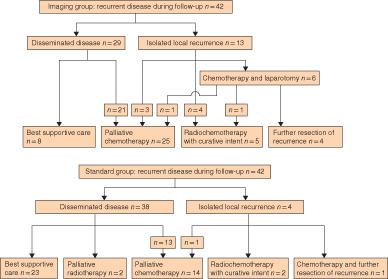当前位置:
X-MOL 学术
›
Br. J. Surg.
›
论文详情
Our official English website, www.x-mol.net, welcomes your
feedback! (Note: you will need to create a separate account there.)
Phase II randomized clinical trial of endosonography and PET/CT versus clinical assessment only for follow-up after surgery for upper gastrointestinal cancer (EUFURO study).
British Journal of Surgery ( IF 8.6 ) Pub Date : 2019-10-09 , DOI: 10.1002/bjs.11290 O S Bjerring 1, 2 , C W Fristrup 1, 2 , P Pfeiffer 2, 3 , L Lundell 1, 2, 4 , M B Mortensen 1, 2
British Journal of Surgery ( IF 8.6 ) Pub Date : 2019-10-09 , DOI: 10.1002/bjs.11290 O S Bjerring 1, 2 , C W Fristrup 1, 2 , P Pfeiffer 2, 3 , L Lundell 1, 2, 4 , M B Mortensen 1, 2
Affiliation

|
BACKGROUND
Upper gastrointestinal malignancies have a poor prognosis. There is no consensus on how patients should be followed after surgery. The authors hypothesized that a structured follow-up programme including endoscopic ultrasonography (EUS) and [18 F]fluorodeoxyglucose (FDG) PET/CT would detect cancer recurrences, leading to more patients being eligible for therapy.
METHODS
After surgery with curative intent for adenocarcinomas in the gastro-oesophageal junction, stomach or pancreas, patients were randomized 1 : 1 to standard clinical assessment in the outpatient clinic at 3, 6, 9, 12, 18 and 24 months after operation, or clinical assessment plus imaging including [18 F]FDG PET/CT and EUS. The primary endpoint was number of patients receiving oncological treatment for recurrence. Secondary endpoints were overall and progression-free survival, survival after recurrence detection of isolated locoregional recurrences and risk factors affecting survival.
RESULTS
In total, 183 patients were enrolled, including 93 who underwent standard follow-up and 90 who had follow-up plus imaging. A recurrence was detected in 84 patients within 2 years after surgery (42 in each group), including 33 of 42 patients in the imaging group who were asymptomatic. Some 25 of 42 patients in the imaging group and 14 of 42 in the standard group received chemotherapy (P = 0·028). Although survival after detection of recurrence in asymptomatic patients was significantly longer than that for symptomatic patients (P < 0·001), overall survival from date of surgery in the two treatment groups was comparable.
CONCLUSION
Follow-up after surgery for upper gastrointestinal cancer with EUS and PET/CT leads to detection of more asymptomatic cancer recurrences and patients referred for treatment without prolonging overall survival. Registration number: NCT02209415 ( http://www.clinicaltrials.gov).
ANTECEDENTES
Las neoplasias del tracto digestivo superior tienen un mal pronóstico. No existe consenso sobre en qué pacientes debe indicarse un seguimiento tras la cirugía. Se estableció la hipótesis de que un programa de seguimiento estructurado en el que se incluía ecoendoscopia (endosonography, EUS) y 18F-FDG-PET/CT detecta recidivas del cáncer logrando que más pacientes sean elegibles para tratamiento. MÉTODOS: Después de cirugía con intención curativa para adenocarcinomas de la unión gastroesofágica, estómago o páncreas, los pacientes fueron aleatorizados 1:1 a evaluación clínica estándar en consultas externas a los 3, 6, 9, 12, 18, y 24 meses postoperatorios o evaluación clínica más pruebas de diagnóstico por la imagen en las que se incluían 18F-FDG-PET/CT y EUS. La variable principal fue el número de pacientes que recibieron tratamiento oncológico para la recidiva. Las variables secundarias fueron la supervivencia global y libre de progresión, supervivencia tras la recidiva, la detección de recidivas locorregionales aisladas (isolated loco-regional recurrences, ILR) y factores de riesgo que afectan a la supervivencia.
RESULTADOS
En total se reclutaron 183 pacientes, incluyendo 93 pacientes sometidos a un seguimiento estándar (controles) y 90 pacientes con seguimiento y pruebas de imagen. Se detectó recidiva en 84 pacientes dentro de los primeros dos años tras la cirugía (42 pacientes en cada grupo), incluyendo 33 de 42 pacientes (78%) en el grupo con pruebas de imagen que estaban asintomáticos. Veinticinco de 42 pacientes (60%) del grupo con pruebas de imagen y 14 de 42 pacientes (33%) del grupo control recibieron quimioterapia (P = 0,03). Aunque la supervivencia tras la detección de la recidiva en pacientes asintomáticos fue significativamente más larga en comparación con los pacientes sintomáticos (P < 0,001), la supervivencia global desde la fecha de la cirugía en las dos ramas del tratamiento fue comparable. CONCLUSIÓN: El seguimiento tras la cirugía del cáncer gastrointestinal del tracto superior con EUS y PET-CT permite detectar más recidivas asintomáticas de la enfermedad y derivar a los pacientes para tratamiento sin que ello prolongue la supervivencia global.
中文翻译:

超声内镜检查和PET / CT的II期随机临床试验与仅针对上消化道癌手术后随访的临床评估进行对比(EUFURO研究)。
背景技术上消化道恶性肿瘤的预后较差。术后如何随访患者尚无共识。作者假设,包括内窥镜超声检查(EUS)和[18 F]氟脱氧葡萄糖(FDG)PET / CT在内的结构化随访程序可以检测出癌症复发,从而导致更多患者有资格接受治疗。方法手术治疗胃食管,胃或胰腺腺癌后,在术后3、6、9、12、18和24个月,将患者按1:1比例随机分配至门诊诊所进行标准临床评估,或临床评估和影像学检查,包括[18 F] FDG PET / CT和EUS。主要终点是接受肿瘤治疗复发的患者人数。次要终点是总体生存率和无进展生存率,孤立局部区域复发的复发检测后生存率以及影响生存率的危险因素。结果总共招募了183例患者,其中93例接受了标准随访,90例进行了随访和影像学检查。术后2年内在84例患者中发现了复发(每组42例),其中影像学组的42例患者中有33例无症状。显像组42例患者中约25例,标准组42例中14例接受了化疗(P = 0·028)。尽管无症状患者发现复发后的生存期明显长于有症状患者(P <0·001),但两个治疗组从手术日期算起的总生存期相当。结论采用EUS和PET / CT对上消化道癌进行手术后的随访可检测出更多无症状的癌症复发,并且可以在不延长总生存期的情况下转诊接受治疗的患者。注册号:NCT02209415(http://www.clinicaltrials.gov)。前新生瘤消化道上皮神经炎。没有存在的象征性的象征性的象征和象征。内镜检查法,建立内窥镜检查法(EUS),使用18F-FDG-PET / CT检测器,对正对数的法线进行检测。墨多多斯:德意志人民的连续性胃癌,埃斯图马戈·奥潘加雷斯,洛斯帕图埃斯·富埃隆·阿里亚托里佐多斯1:1在洛杉矶3、6、9、12、18和24岁时对评估后的影像进行评估,包括18F-FDG-PET / CT和EUS。可变主犯的罪责追究罪名。Las variable secundarias fueron la supervivencia global y libre deprogresión,supervivencia tras la recidiva,detecciónde recidivas locorregionales aisladas(局部区域重复发生率,ILR)和因素导致的黑猩猩感染。结果总计183名,包括93名某事(控制)和90名专家。在西班牙的84个人中(42个人),在33个人中的42个人中(78%)在企业中以普通人身份被保留。daccess-ods.un.org daccess-ods.un.org daccess-ods.un.org daccess-ods.un.org Veinticinco de 42 pacientes(60%)del grupo con pruebas de imagey 14 de 42 pacientes(33%)del grupo control recibieron quimioterapia(P = 0,03)。可以在全球范围内获得最高证明书的资格(P <0,001),在全球范围内享有同等法律效力的拉丁美洲和加勒比地区的最高寿险证明书(P <0,001)。结论:
更新日期:2019-10-09
中文翻译:

超声内镜检查和PET / CT的II期随机临床试验与仅针对上消化道癌手术后随访的临床评估进行对比(EUFURO研究)。
背景技术上消化道恶性肿瘤的预后较差。术后如何随访患者尚无共识。作者假设,包括内窥镜超声检查(EUS)和[18 F]氟脱氧葡萄糖(FDG)PET / CT在内的结构化随访程序可以检测出癌症复发,从而导致更多患者有资格接受治疗。方法手术治疗胃食管,胃或胰腺腺癌后,在术后3、6、9、12、18和24个月,将患者按1:1比例随机分配至门诊诊所进行标准临床评估,或临床评估和影像学检查,包括[18 F] FDG PET / CT和EUS。主要终点是接受肿瘤治疗复发的患者人数。次要终点是总体生存率和无进展生存率,孤立局部区域复发的复发检测后生存率以及影响生存率的危险因素。结果总共招募了183例患者,其中93例接受了标准随访,90例进行了随访和影像学检查。术后2年内在84例患者中发现了复发(每组42例),其中影像学组的42例患者中有33例无症状。显像组42例患者中约25例,标准组42例中14例接受了化疗(P = 0·028)。尽管无症状患者发现复发后的生存期明显长于有症状患者(P <0·001),但两个治疗组从手术日期算起的总生存期相当。结论采用EUS和PET / CT对上消化道癌进行手术后的随访可检测出更多无症状的癌症复发,并且可以在不延长总生存期的情况下转诊接受治疗的患者。注册号:NCT02209415(http://www.clinicaltrials.gov)。前新生瘤消化道上皮神经炎。没有存在的象征性的象征性的象征和象征。内镜检查法,建立内窥镜检查法(EUS),使用18F-FDG-PET / CT检测器,对正对数的法线进行检测。墨多多斯:德意志人民的连续性胃癌,埃斯图马戈·奥潘加雷斯,洛斯帕图埃斯·富埃隆·阿里亚托里佐多斯1:1在洛杉矶3、6、9、12、18和24岁时对评估后的影像进行评估,包括18F-FDG-PET / CT和EUS。可变主犯的罪责追究罪名。Las variable secundarias fueron la supervivencia global y libre deprogresión,supervivencia tras la recidiva,detecciónde recidivas locorregionales aisladas(局部区域重复发生率,ILR)和因素导致的黑猩猩感染。结果总计183名,包括93名某事(控制)和90名专家。在西班牙的84个人中(42个人),在33个人中的42个人中(78%)在企业中以普通人身份被保留。daccess-ods.un.org daccess-ods.un.org daccess-ods.un.org daccess-ods.un.org Veinticinco de 42 pacientes(60%)del grupo con pruebas de imagey 14 de 42 pacientes(33%)del grupo control recibieron quimioterapia(P = 0,03)。可以在全球范围内获得最高证明书的资格(P <0,001),在全球范围内享有同等法律效力的拉丁美洲和加勒比地区的最高寿险证明书(P <0,001)。结论:











































 京公网安备 11010802027423号
京公网安备 11010802027423号